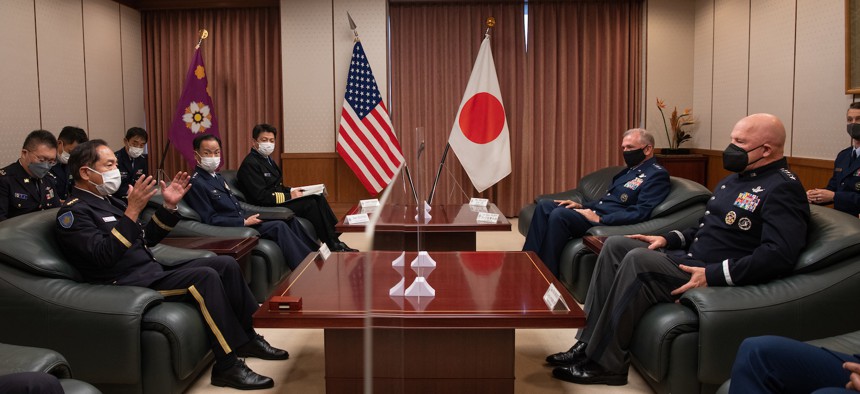
U.S. Space Force Gen. John W. Raymond, Chief of Space Operations, and his staff, right, speaks with Chief of Staff of the Japan Joint Staff, Gen. Koji Yamazaki, and his staff, left, during his visit to engage with senior officials from Japan’s Ministry of Defense, in Tokyo, Japan, Oct. 5, 2022. U.S. Navy / Mass Communication Specialist 2nd Class Jack D. Aistrup
The Air & Space Brief: More KC-46 camera delays; Satellite replacement; USAF climate plan; and more
Welcome to the Defense One Air and Space newsletter. Here are our top stories this week:
More problems for Pegasus. The Air Force last week announced that the upgraded refueling camera system for its KC-46 tanker won’t be ready until October 2025, Air & Space Forces Magazine reported. That’s 19 months after the previously agreed-upon delivery date for the Remote Vision System 2.0; the original RVS, which allows the boom operator to see the boom through a video feed, has been plagued with problems since the service received its first KC-46s in 2019.
Backup satellites: The Pentagon must have satellites available on the ground and already in orbit to be able to quickly reconstitute capabilities to be ready for a potential conflict in orbit, ULA’s Tory Bruno argues in an op-ed. Storing extra satellites in orbit makes sense for proliferated constellations with low-Earth orbit, he says, because of their short service life and cheap launch costs. But for larger, more expensive satellites, Bruno suggested building one ahead to always have the next satellite ready to launch to replace a damaged asset.
More combat power, less fuel: The Air Force wants to get to net-zero carbon emissions at its bases by fiscal 2046, and to develop aircraft that are dramatically more fuel efficient, as part of its recently released Climate Action Plan, Air Force Times reported. The plan also outlines steps to modernize its infrastructure to be more resilient in the face of increasingly extreme weather.
“We must prioritize air and space dominance in a security environment shaped by a changing climate, yet also recognize and reduce the department’s role in contributing to climate change,” Air Force Secretary Frank Kendall wrote in the plan.
Cold War landmarks: The National Park Service has identified more than 20 Cold War sites worthy of consideration to be National Historic Landmarks, including Atlas ICBM launch facilities in California, Wyoming, and Colorado; the Cheyenne Mountain Complex in Colorado; the Strategic Air Command Ground Alert Facility at Mountain Home Air Force Base, Idaho; and Strategic Air Command Headquarters at Offutt AFB, Nebraska. Seventeen Cold War-related sites have already been designated as National Historic Landmarks, including Air Force Facility Missile Site 8 Military Reservation in Arizona, according to NPS.
Sign up to get The Air & Space Brief every Tuesday from Jennifer Hlad, Defense One’s news editor. On this day in 1910, Theodore Roosevelt took off as a passenger in a Wright biplane piloted by Archibald Hoxsey, becoming the first president to fly.
 From Defense One
From Defense One
How Should We Quickly Replace Downed Satellites? // Tory Bruno
Keep extras in orbit? Have them ready on the ground? It depends.
Defense One Radio, Ep. 110: Rethinking logistics, air bases, space debris, and more. // Defense One Staff
The chiefs of the Marines and Air Force join a half-dozen experts to share lessons from Ukraine, the future of Pacific basing, and more.
Oversight of Special Operations Forces Requires Better Data, Watchdog Says // Edward Graham
The data collected by U.S. Special Operations Command lacks consistency and transparency, the Government Accountability Office found.




